Line S2 is a S-Bahn line in the Rhein-Ruhr network. It starts in Dortmund Hauptbahnhof and runs westerly. During weekdays one service per hour runs each to Essen Hauptbahnhof and Recklinghausen Hauptbahnhof using Stadler FLIRT 3XL units.

Line S 9 is an S-Bahn line on the Rhine-Ruhr network, operated by DB Regio. It runs from Recklinghausen Hbf / Haltern am See in the north through Gladbeck West - Essen Hbf to Hagen (Westphalia) Main Station in the south. During the day two services per hour run between Wuppertal and Gladbeck West, one service per hour between Gladbeck and Recklinghausen Hbf and Gladbeck and Haltern am See and one service per hour between Wuppertal and Hagen, using FLIRT 3XL electric multiple units.
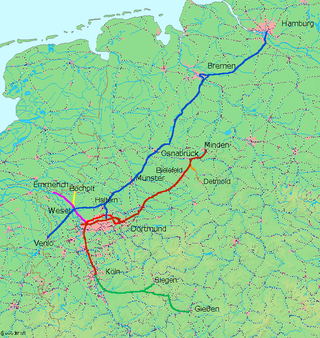
The 64 km long Cologne–Duisburg railway is one of the most important lines in Germany. It is the main axis for long distance and urban passenger rail services between Cologne and the Ruhr, served by Intercity Express, Intercity, Regional Express, regionalbahn and S-Bahn trains. It was the first section built of the Cologne-Minden trunk line and is one of the oldest railways in Germany. It was opened in 1845/46 and has been repeatedly modernized and expanded. Today the route comprises two or three double lines and is electrified throughout.
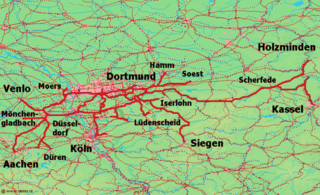
The Witten/Dortmund, Oberhausen/Duisburg railway is one of the most important railways in Germany. It is the main axis of long distance and regional rail transport on the east–west axis of the Ruhr and is served by Intercity-Express, InterCity, Regional-Express, Regionalbahn and S-Bahn trains.

The Duisburg-Dortmund Railway is an important and historically significant railway in Germany. It is a major axis for long distance and regional passenger freight transport in the northern Ruhr. It is served by Intercity-Express, InterCity, Regional-Express, Regionalbahn and S-Bahn trains. It includes the central stations of Duisburg, Oberhausen, Gelsenkirchen, Dortmund and Wanne-Eickel and the regionally important stations of Essen-Altenessen and Herne. It is the middle section of the Cologne-Minden trunk line from Cologne-Deutz to Minden. It was opened in 1847 and has been modernised and developed several times since then. Today, it has two to four tracks and is electrified and classified as a main line.

Wanne-Eickel Hauptbahnhof is a railway station in the former city of Wanne-Eickel, now part of Herne in western Germany.

The Welver–Sterkrade railway is a former through railway line from the Westphalian town of Welver to Sterkrade in the western Ruhr region in Germany, which is now broken into four disconnected sections. Because its route ran along the Emscher river it was known as the Westphalian Emscher Valley Railway.
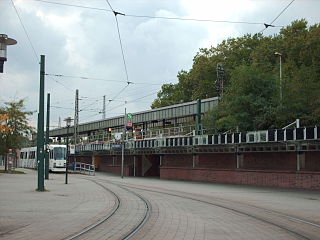
Essen-Altenessen is a railway station situated in Essen in western Germany. It is served by Regional-Express service RE3 (Rhein-Emscher-Express), Regionalbahn lines RB32 (Rhein-Emscher-Bahn) and RB35 (Emscher-Niederrhein-Bahn) and lines U11 and U17 of the Essen Stadtbahn.
The Düsseldorf-Derendorf–Dortmund Süd railway is a partially closed line in the German state of North Rhine-Westphalia from Düsseldorf-Derendorf station to Dortmund South station. Parts of it are still busy, including two sections used for the Rhine-Ruhr S-Bahn.
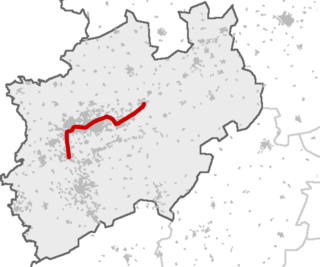
The Rhein-Emscher-Express is a Regional-Express service in the German state of North Rhine-Westphalia (NRW), running from Düsseldorf via Duisburg, Gelsenkirchen and Dortmund to Hamm. It connects with the rest of the regional rail network of NRW in Düsseldorf, Duisburg, Oberhausen, Wanne-Eickel, Dortmund and Hamm. In addition, it connects in Düsseldorf, Duisburg, Oberhausen, Dortmund and Hamm with long-distance services.

Bochum-Langendreer station is now a stop on the Rhine-Ruhr S-Bahn in the district of Langendreer in eastern Bochum in the German state of North Rhine-Westphalia. Langendreer formerly had a 40 hectare marshalling yard, which is now used as a depot, with the location code of EBLA. Until the 1980s, the yard was also the location of a passenger station, which was served by express trains.
The Mülheim-Heißen–Oberhausen-Osterfeld Nord railway is a line that formerly ran continuously in the western Ruhr region from Heißen to Osterfeld in the German state of North Rhine-Westphalia.

The Oberhausen-Osterfeld Süd–Hamm railway, also called the Hamm-Osterfeld line, is a 76-kilometre long double-track electrified main line railway at the northern edge of the Ruhr in the German state of North Rhine-Westphalia.
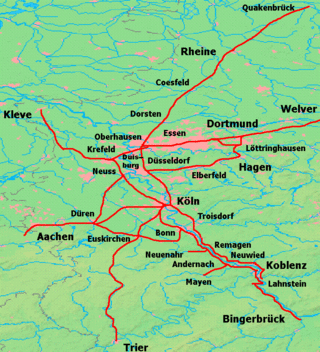
The Osterath–Dortmund-Süd railway is a historically significant line in the German state of North Rhine-Westphalia. Parts of it are closed, much of it is now used for freight only, but several sections are still used for Regional-Express, Regionalbahn or Rhine-Ruhr S-Bahn services.
The Duisburg-Wedau–Bottrop Süd railway is a railway used only for freight in the German state of North Rhine-Westphalia. It runs from the former Duisburg-Wedau freight yard as well as from the Duisburg-Hochfeld Süd freight yard via Oberhausen West freight yard to Bottrop Süd freight yard. The railway connects these and many other important lines in Duisburg, Oberhausen and Bottrop. In particular, it provides a connection to the Duisburg and Ruhrort river ports.
The Duisburg-Ruhrort–Dortmund railway was built by the Cologne-Minden Railway Company in the area to the north of its original Ruhr line to improve connections to mines and factories in the northern Ruhr region, which is now in the German state of North Rhine-Westphalia.
The Bochum–Essen/Oberhausen railway was built by the Bergisch-Märkische Railway Company to the north of its main line through the central Ruhr to tap traffic from mines and factories in the northern Ruhr region, which is now in the German state of North Rhine-Westphalia.
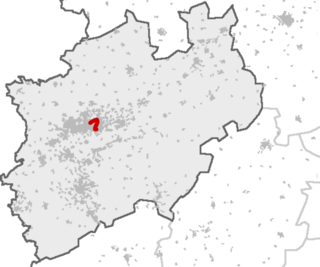
The Bochum–Gelsenkirchen railway, also known as the Glückauf-Bahn, is a passenger railway from Bochum Central Station (Hauptbahnhof) to Gelsenkirchen Central Station in the German state of North Rhine-Westphalia. It is served by Regionalbahn passenger service RB 46). It is also used by freight traffic from Bochum freight yard at the former Bochum Süd station and Bochum-Präsident to Gelsenkirchen-Schalke Nord. The line was built in sections between 1867 and 1876 of the Bergisch-Märkische Railway Company. The curve connecting to Bochum Central Station was opened in 1979.

Bochum Nord station was a station on the Ostring in the city of Bochum in the German state of North Rhine-Westphalia. It was built by the Rhenish Railway Company between 1871 and 1874 and opened on 15 October 1874. The station, which was originally called Bochum Rheinisch ("Rhenish") station, for a long time served passenger and freight traffic on the Osterath–Dortmund Süd railway.
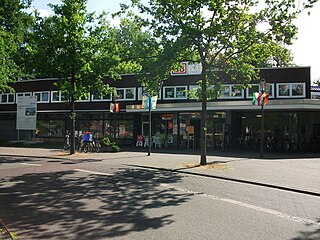
Dülmen station is one of two operating tower stations in the German state of North Rhine-Westphalia. It is located in Dülmen in western Münsterland. It is at the crossing of the Wanne-Eickel–Hamburg and the Dortmund–Enschede railways.














